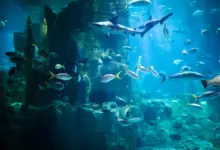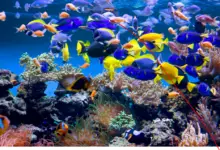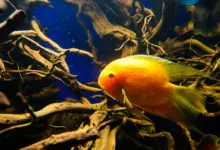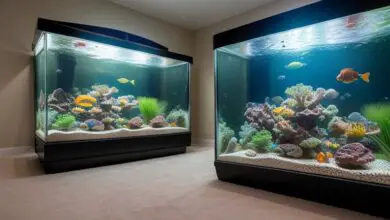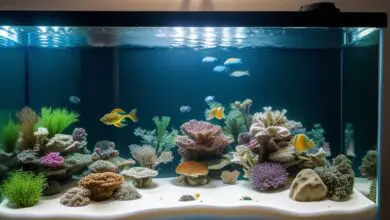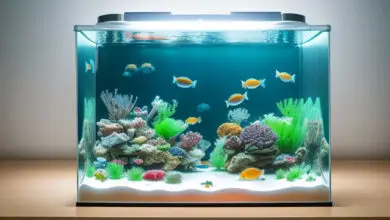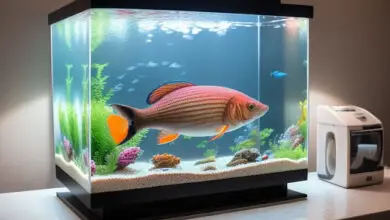How to Build Your Own Self-Sustaining Aquarium at Home

Have you ever dreamed of having a little aquatic world thriving right in your own living room? A self-sustaining aquarium allows you to create a balanced, closed-loop ecosystem filled with live plants and fish. Follow this beginner’s guide to learn everything you need to set up and maintain your own sustainable tank habitat.
Choose the Right Aquarium Tank and Equipment
The first step is selecting an aquarium tank. A standard 10-gallon tank is a good place to start for novice aquarists. Make sure to purchase one made out of thick, clear glass with a plastic frame. Tempered glass tanks should be avoided since they cannot be drilled to install filtration systems.
You’ll also need a few basic pieces of equipment:
- Filter – This is crucial for keeping the water clean. An external canister filter that sits below the tank is ideal as it does not take up space inside the aquarium. Choose one correctly sized for your tank volume.
- Substrate – Cover the bottom with 2-3 inches of fine gravel or sand. This gives plants something to root in and provides surface area for helpful bacteria.
- Lighting – Plants need adequate lighting to thrive. Select an LED aquarium light that allows you to adjust color temperature and intensity. Time it for 8-12 hours per day.
- Heater – Maintain a stable water temperature between 72-82°F. Choose a submersible heater correctly sized for your tank volume.
Introduce Hardscape Elements
Aquascaping refers to arranging decorative elements like rocks, driftwood, and caves prior to adding any living things. Place heavier items first to create a foundation, then build upwards with lighter materials.
Aim for a natural look with plenty of hiding spots. Rock crevices and caves formed from stacked stones make perfect shelters for timid fish. Driftwood also adds visual interest while lowering the water’s pH level safely.
Spend time getting the hardscape layout right. An appealing foundation helps set the overall look and feel of the entire aquarium once filled out with plants, fish, and other living elements.
Add Nutrient-Exporting Plants
Live aquarium plants form an integral part of a self-sustaining ecosystem. Through photosynthesis, greens remove waste products like ammonia and carbon dioxide while generating oxygen.
Start by planting several nutrient-exporting species. These fast-growing stems and floating varieties absorb large amounts of nitrogen and phosphorous compounds from the water, helping prevent algae formation.
Great starter options include:
- Anacharis – Fast-spreading stems perfect for beginner aquarists. Help control algae and filter pollutants.
- Water Wisteria – Vibrant green leaves on trailing stems soak up dissolved organics. Grows quickly to fill out the tank.
- Duckweed – Tiny floating plants that spread rapidly across the water surface, absorbing excess nutrients in the process.
Place these cleanup crew members around the aquarium and watch them expand to take up excess nutrients. Trim as needed so they do not completely overrun the tank.
Choose Peaceful Community Fish
Adding the right freshwater fish completes your miniature underwater habitat. For newcomers, it is best to stick with peaceful community species suitable for a planted aquarium setup.
Here are some of the most popular beginner choices:
- Platies – Colorful, active schooling fish perfect for community tanks. Get 3-4 males and females to allow breeding.
- Zebra Danios – Striped fish that swim in constant motion. A playful shoaling species that loves planted tanks.
- Corydoras Catfish – Armored bottom feeders ideal for stirring up substrate to prevent anaerobic spots. Get 6 or more as they are social.
- Cherry Barbs – Bright red beauties that display comfortingly familiar schooling behavior. Max out at 12-15 per tank.
Mix and match compatible varieties to create a vibrant underwater community. Avoid aggressive species like cichlids or goldfish who may disturb more timid tankmates or eat delicate plants.
When first adding fish, limit numbers to just a few hardy varieties and let the aquarium continue to mature and establish naturally occurring food sources before fully stocking. This allows beneficial bacteria populations vital for the nitrogen cycle to catch up, maintaining cleaner water. Monitor water parameters closely and only add more fish once levels test consistently safe.
Cultivate Natural Food Sources
In a balanced, self-contained ecosystem, the occupants will find many natural food sources without much manual feeding required. Grow beneficial microfauna populations by “seeding” the tank with living foods.
Infusoria
This microscopic community that blooms on decaying plant matter forms the basis of the aquatic food web. To culture infusoria:
- Place a slice of vegetables like cucumber or zucchini into a jar of aged tank water.
- Allow to decompose for 1-2 weeks until a hazy film containing millions of microorganisms develops.
- Remove the rotten veggies then siphon this nutrient-dense culture into the main tank.
Tiny creatures like daphnia and seed shrimp will thrive on infusoria, in turn providing a natural food source for small fish fry and juvenile tank inhabitants.
Daphnia, Cyclops & Brine Shrimp
Other excellent live foods to introduce include planktonic crustaceans like daphnia, cyclops, and brine shrimp. They serve as an important link in the food chain between microscopic infusoria and larger fish. Maintain breeding populations by regularly harvesting a portion for manual feeding while leaving the rest to reproduce and spread naturally.
Achieve Ideal Water Parameters
While a balanced ecosystem keeps itself clean through biological processes, you do need to monitor water quality and correct any dangerous spikes immediately.
Use an aquarium water testing kit on a weekly basis to check critical levels:
- pH – Between 7.0-8.0
- Ammonia & Nitrites – Undetectable (0 ppm)
- Nitrates – Under 40 ppm
Carry out 20% water changes whenever ammonia or nitrites rise above safe limits to protect your inhabitants. Over time, the system should reach equilibrium with lower maintenance needs.
Avoid Common Pitfalls
It takes patience and diligence to establish a thriving ecosystem that maintains itself naturally overtime. Here are some key pitfalls for beginners to avoid:
- Adding too many fish too quickly – Go slow to allow enough time for beneficial bacteria to build up avoiding dangerous ammonia spikes.
- Insufficient plant mass – Not cultivating enough fast-growing stem plants often results in algae takeovers from the start.
- Poor substrate choice – Using crushed coral or giant gravel rather than a fine sand/gravel mix leads to anaerobic gas pockets that can kill inhabitants.
- Equipment failures – Issues like broken heaters, failing pumps or burnt out lights can crash the ecosystem if not caught and corrected in time.
Maintain Balance Long-term
A perfectly calibrated aquarium environment requires minimal interference after the initial setup stage. Feed inhabitants only sparingly, allowing natural food sources to dominate. Prune plants to prevent overgrowth and siphon mulm buildup from the substrate surface monthly. Top off with fresh water to offset evaporation loss.
Test critical water parameters weekly and carry out water changes whenever levels go out of bounds. Wipe down glass algae regularly and clean equipment per manufacturer instructions.
That covers the basics of constructing your own low maintenance underwater world! Patience through the initial 1-2 month cycle period is key but the reward is a beautiful slice of thriving nature right in your living room.
Troubleshooting Common Problems
Despite your best efforts, issues can sometimes arise even in established tanks. Here are some common problems and troubleshooting tips:
Cloudy Water
Cloudy or milky water is typically caused by one of two issues – bacterial blooms or green water algae growth.
For bacterial blooms, check ammonia levels and carry out water changes until the cycle rebalances. Limit feedings to once daily until water clarity improves.
If caused by single-celled algae suspended throughout the water column, install a UV sterilizer to kill the bloom within a few days. Also reduce lighting duration to 6 hours per day temporarily.
Stringy Brown Algae
Long wispy brown strands are a type of diatom algae. While not harmful, they are unsightly and indicate excess silicates or phosphates. Use a gravel vacuum to manually remove what you can reach. Do larger water changes and scrub equipment and decor to eliminate this food source until the algae eventually dies back.
Green Spot Algae
Small circular green dots on aquarium glass, slow-growing plant leaves or decor most often results from low phosphates or CO2 levels. Scrape off manually with each water change and adjust lighting down if growth seems excessive. You can leave some green spot algae as many fish graze on it. Just keep rapid spreading in check.
Stunted Plant Growth
If aquatic plants are struggling with yellowing, twisted leaves and minimal new shoots, lack of nutrients and proper lighting are likely to blame. Review fertilization routine and CO2 injection if applicable. Also replace old bulbs or raise lights higher to provide brighter illumination without burning plants.
Trim back any melted growth to allow new leaves to emerge healthily. Combine these interventions until plants perk up with vigorous expansion.
Expand Your Aquatic Garden
Once your initial ecosystem matures after 6-12 months, consider expanding the diversity with any of the following optional enhancements:
- Introduce cleaner crew algae eaters like nerite snails, otos, or Amano shrimp for added interest and surface cleaning
- Create specialized natural niches like a moss wall or floating betta log for shy species
- Attach slow growing anubias or bucephalandra to hardscape to add color without overtaking delicate root feeders
- Mix inactive natural substrate additives like crushed coral or dolomite into areas for grazing catfish
- Install a reverse daylight cycle refugium sump to cultivate infusoria and microfauna feeding the display tank
Continuing to tweak the environment transforms your aquarium into a wide-ranging landscape that mimics nature. Aim for diversity across flora, fauna and physical elements – much like a real lake or pond ecosystem.
Conclusion
A properly planned and patiently nurtured enclosed ecosystem leads to a resilient, sustainable aquatic habitat requiring minimal inputs long-term. By following the steps outlined in this guide and avoiding common missteps, you can create a stunning slice of natural tranquility right at home.
Give your balanced ecosystem 6-12 months to fully mature and reach equilibrium. Along the way, enjoy engaging moments like spotting tiny seed shrimp dancing in streams of bubbles or a pair of clown killifish hatching a new brood. Marvel at the steady drip of water droplets off emerald anubias leaves and watch schools of harlequin rasboras shimmering through golden plant stems.
Your established paludarium will provide a calming, living piece of art and a regular source of relaxation regardless of what else is happening in the outside world on any given day. The glass of your display tank also serves as a looking glass reminding you of humanity’s shared connection and responsibility towards the precious aquatic environments all around us.
